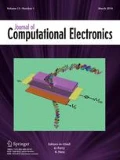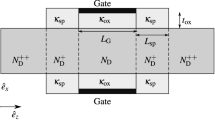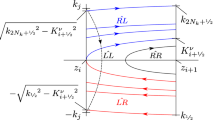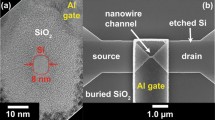Abstract
A deterministic solver for the analysis of microscopic noise and small-signal fluctuations in junctionless nanowire field-effect transistors is presented, which is based on a self-consistent and simultaneous solution of the Poisson/Schrödinger/Boltzmann equations. It is verified that the numerical framework fulfills the vital properties of reciprocity and passivity in the small-signal sense, and yields Johnson–Nyquist noise under equilibrium conditions. Key figures such as the cutoff frequency, drain excess noise factor, the Fano factor, and gate/drain correlation coefficient are presented at various bias conditions. In this work we show that similar to the inversion-mode MOSFETs, the gate and drain current noises mainly stem from the warm electrons at the source side, whereas the hot electrons do not have a significant contribution. Also, our results show that the device behaves similar to long-channel FETs in terms of its excess noise even for a channel length of 10 nm, due to the strong control of its electrostatics by the all-around gate.










Similar content being viewed by others
References
Lee, C.-W., Afzalian, A., Akhavan, N.D., Yan, R., Ferain, I., Colinge, J.-P.: Junctionless multigate field-effect transistor. Appl. Phys. Lett. 94(5), 0535111–0535112 (2009)
Lee, C.-W., Borne, A., Ferain, I., Afzalian, A., Yan, R., Akhavan, N.D., Razavi, P., Colinge, J.-P.: High-temperature performance of silicon junctionless MOSFETs. IEEE Trans. Electron Dev. 57(3), 620–625 (2010)
Doria, R.T., Pavanello, M.A., Trevisoli, R., de Souza, M.: Junctionless multiple-gate transistor for analog applications. IEEE Trans. Electron Dev. 58(8), 2511–2519 (2011)
Cho, S., Kim, K.R., Park, B.-G., Kang, I.M.: RF performance and small-signal parameter extraction of junctionless silicon nanowire transistors. IEEE Trans. Electron Dev. 58(5), 1388–1396 (2011)
Doria, R.T., Trevisoli, R., de Souza, M., Pavanello, M.A.: Physical insights on the dynamic response of junctionless nanowire transistors. In: Symposium on Microelectronics Technology and Devices (SBMicro) (2016)
Jungemann, C., Grasser, T., Neinhüs, B., Meinerzhagen, B.: Failure of moments-based transport models in nanoscale devices near equilibrium. IEEE Trans. Electron Dev. 52(11), 2404–2408 (2005)
Ruić, D., Jungemann, C.: Numerical aspects of noise simulation in MOSFETs by a Langevin–Boltzmann solver. J. Comput. Electron. 14(1), 21–36 (2015)
Kranti, A., Yan, R., Lee, C.W., Ferain, I., Yu, R., Akhavan, N.D., Razavi, P., Colinge, J.: Junctionless nanowire transistor (JNT): properties and design guidelines. In: 2010 Proceedings of the European Solid-State Device Research Conference (ESSDERC) (2010)
Sorée, B., Magnus, W., Vandenberghe, W.: Low-field mobility in ultrathin silicon nanowire junctionless transistors. Appl. Phys. Lett. 99, 233 (2011)
Jin, S., Fischetti, M.V., Tang, T.-W.: Modeling of electron mobility in gated silicon nanowires at room temperature: surface roughness scattering, dielectric screening, and band nonparabolicity. J. Appl. Phys. 102, 1 (2007)
Hong, S.-M., Pham, A.T., Jungemann, C.: Deterministic solvers for the Boltzmann transport equation. Computational microelectronics, Wien. Springer, New York (2011)
Lucci, L., Palestri, P., Esseni, D., Bergagnini, L., Selmi, L.: Multisubband Monte Carlo study of transport, quantization, and electron-gas degeneration in ultrathin SOI n-MOSFETs. IEEE Trans. Electron Dev. 54, 1156–1164 (2007)
Ando, T., Fowler, A., Stern, F.: Electronic properties of two-dimensional systems. Rev. Mod. Phys. 54, 437–672 (1982)
Polizzi, E.: Density-matrix-based algorithm for solving eigenvalue problems. Phys. Rev. B 79, 115112 (2009)
Jungemann, C., Meinerzhagen, B.: Hierarchical Device Simulation: The Monte-Carlo Perspective Computational Microelectronics, Wien. Springer, New York (2003)
Jungemann, C., Pham, A.-T., Meinerzhagen, B., Ringhofer, C., Bollhöfer, M.: Stable discretization of the Boltzmann equation based on spherical harmonics, box integration, and a maximum entropy dissipation principle. J. Appl. Phys. 100, 024502-1–024502-13 (2006)
Kim, H., Min, H.S., Tang, T.W., Park, Y.J.: An extended proof of the Ramo-Shockley theorem. Solid State Electron. 34, 1251–1253 (1991)
Kogan, S.: Electronic Noise and Fluctuations in Solids. Cambridge University Press, Cambridge (1996)
Jungemann, C., Meinerzhagen, B.: Do hot electrons cause excess noise? Solid-State Electron. 50, 674–679 (2006)
Oh, T.-Y., Jungemann, C., Dutton, R.W.: Hydrodynamic simulation of RF noise in deep-submicron MOSFETs. In: SISPAD’03, (Boston (USA)), pp. 87–90 (2003)
Goo, J.-S., Choi, C.-H., Danneville, F., Morifuji, E., Momose, H.S., Yu, Z., Iwai, H., Lee, T.H., Dutton, R.W.: An accurate and efficient high frequency noise simulation technique for deep submicron MOSFETs. IEEE Trans. Electron Dev. 47(12), 2410–2419 (2000)
Jungemann, C., Neinhüs, B., Nguyen, C.D., Scholten, A.J., Tiemeijer, L.F., Meinerzhagen, B.: Numerical modeling of RF noise in scaled MOS devices. Solid State Electron. 50, 10–17 (2006)
Author information
Authors and Affiliations
Corresponding author
Appendix
Appendix
In order to calculate the small-signal terminal currents, we need to derive a formulation of the Ramo–Shockley theorem [17] that is consistent with our simulation framework, i.e., one-dimensional BE along the transport direction and two-dimensional SE in the transverse planes. In what follows, the details of such formulation are presented.
The small-signal current of the k-th contact can be expressed as:
where \(\mathbf {{\underline{J}}}^\nu (\mathbf{{r}})\) is the three-dimensional small-signal current density and \(\partial D_k\) comprises the set of points of the k-th contact. Defining the Ramo–Shockley test functions as the solutions to the Laplace equation within the device:
we can safely extend the integration region to the whole surface and then employ the divergence theorem to get:
with
and the applied contact bias \({\underline{V}}_i^C\) at contact i. A bit more work has to be put into the first integral, because the only quantity we can directly compute is the current in transport direction. We divide the first term into two parts,
where \(\mathbf {{\underline{J}}}_z^\nu (\mathbf{{r}})\) denotes the z-component of \(\mathbf {{\underline{J}}}^\nu (\mathbf{{r}})\), and \(\mathbf {{\underline{J}}}_{\perp }^\nu (\mathbf{{r}})\) is the component in \(x-y\) plane perpendicular to the transport. Neglecting the transport in z-direction (i.e., \(j^\nu (z)=0\)), we have for the first integral:
where we have used the continuity equation:
and the fact that wavefunctions vanish on the boundary of the semiconductor region in transverse planes. The two-dimensional charge density \(\rho ^\nu _\perp (\mathbf{{r}})\) can change with redistribution of electrons in the perpendicular plane either by changes in electrostatic potential or by scattering mechanisms. We need to capture both mechanisms here, while keeping in mind that time evolution of n(z) was already considered in solving the transport equation in order to avoid double-counting. This yields:
where \({\underline{S}}_H(z)\) represents the small-signal scattering term integrated over the total energy. Next, the contribution of \(j^\nu (z)\) to \(\mathbf {{\underline{J}}}_{\perp }^\nu (\mathbf{{r}})\) is calculated, which introduces a transverse current \(\mathbf {J}_{\perp \text {IF}} ^\nu (\mathbf{{r}})\) when the wavefunctions change in z-direction. Hence, this component is attributed to the interface of adjacent z-boxes (see Fig. 11). Averaging this part over time for an arbitrary \(\Delta t\) gives:
with:
The discretized result for this part, therefore, is:
The last term in (19) is very straightforward to calculate, since the z-component of current density is obtained from the solution of Boltzmann equation:
Rights and permissions
About this article
Cite this article
Noei, M., Jungemann, C. Microscopic simulation of RF noise in junctionless nanowire transistors. J Comput Electron 17, 986–993 (2018). https://doi.org/10.1007/s10825-018-1199-4
Published:
Issue Date:
DOI: https://doi.org/10.1007/s10825-018-1199-4





